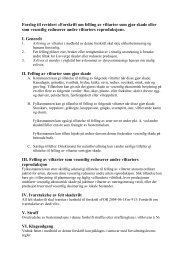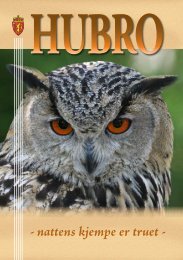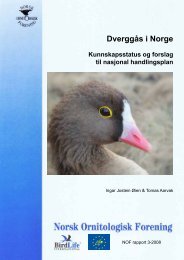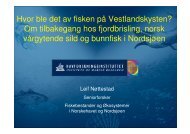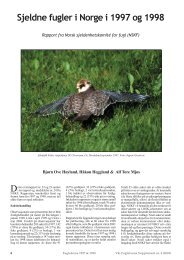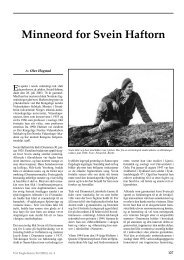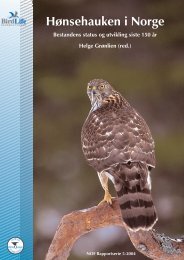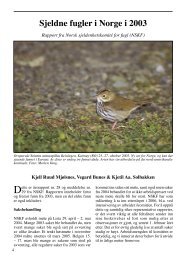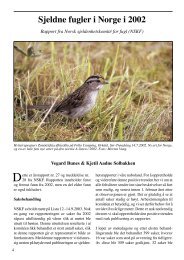Fennoscandian Lesser White-fronted Goose conservation project ...
Fennoscandian Lesser White-fronted Goose conservation project ...
Fennoscandian Lesser White-fronted Goose conservation project ...
Create successful ePaper yourself
Turn your PDF publications into a flip-book with our unique Google optimized e-Paper software.
<strong>Fennoscandian</strong> <strong>Lesser</strong> <strong>White</strong>-<strong>fronted</strong> <strong>Goose</strong> <strong>conservation</strong> <strong>project</strong> – Annual report 1999<br />
<strong>Lesser</strong> <strong>White</strong>-<strong>fronted</strong> <strong>Goose</strong> survey at the East Dongting and<br />
Poyang lakes in China, February 1999<br />
Juha Markkola 1 , Shigeki Iwabuchi 2 , Lei Gang 3 , Tomas Aarvak 4 , Petteri Tolvanen 5 & Ingar Jostein Øien 4<br />
1 North Ostrobothnia Regional Environment Centre, P.O. Box 124, FIN-90101 Oulu, FINLAND, e-mail: juha.markkola@vyh.fi<br />
2 Sendai Science Museum, 4-1 Dainohara Forest Park, Aoba Ward, Sendai, JAPAN 981, e-mail; iwabuchi@sendai-smus.go.jp<br />
3 East Dongting Lake National Nature Reserve, Yueyang City, Hunan Province, 414000, P.R. of CHINA<br />
4 Norwegian Ornithological Society (NOF), Seminarplassen 5, N-7540 Klæbu, NORWAY, e-mails: tomas@birdlife.no, ingar@birdlife.no<br />
5 WWF Finland, Lintulahdenkatu 10, FIN-00500 Helsinki, FINLAND, e-mail: tolvanen@sll.fi<br />
1. Introduction<br />
The unique importance of China as the main wintering quarter for<br />
the eastern populations of the <strong>Lesser</strong> <strong>White</strong>-<strong>fronted</strong> <strong>Goose</strong> (Anser<br />
erythropus, later LWfG) was unknown until 1994, when Jian Jian<br />
Lu presented annual counts of 1,000–10,000 LWfG from China at<br />
the Anatidae 2000 conference in Strasbourg, France (see Anonymous<br />
1995). However, this information was presented in several articles<br />
in Chinese already in the years 1990–1994 (Lu 1990, Hu & Guan<br />
1994, Li et al. 1994, Liu 1994, Liu et al. 1994, Lu and the Waterbird<br />
Specialist Group of the Chinese Ornithological Association 1994;<br />
see Table 1). Lu and the articles mentioned above listed 10 places,<br />
where 50 or more LWfG had been observed and of these the eight<br />
most important are listed on Table 1.<br />
During the period 31 January – 15 February, 1999, after the<br />
Wetlands International <strong>Goose</strong> Specialist Group meeting in<br />
Matsuhsima, Japan, representatives of the Wetlands International<br />
LWfG Task Force visited China in order to survey the East Dongting<br />
Lake area (Hunan province) and Lake Poyang (Jiangxi province).<br />
These sites are supposed to be the two most important wintering<br />
places for the eastern flyway population of the LWfG. The aim of<br />
the survey was to estimate the numbers and distribution of LWfG at<br />
these two well known goose wintering quarters, to collect<br />
demographic data, to calibrate the census techniques between<br />
European, Chinese and Japanese colleagues as well as to negotiate<br />
with Chinese goose specialists and authorities about improving the<br />
<strong>conservation</strong> of the LWfG in these areas.<br />
Of the sites (cf. Table 1), East Dongting Lake is classified mainly<br />
as a wintering area, Qingdao mainly as a staging area and Xingkai<br />
as a pure staging area. The lakes 1, 2, 3, 6 (Figure 1a) and Shenjing<br />
Lake, all belong more or less to the Chang Jiang (Yangtze) river<br />
system. The distance between the East Dongting Lake <strong>Goose</strong> Station<br />
and the administration centre of Poyang Lake Nature Reserve was<br />
measured at 311 km.<br />
All the areas listed in Table 1, except Xinkai (Hanka) Lake and<br />
maybe Huang He are located in climatic zones that provide suitable<br />
wintering conditions for LWfG. However, it is not clear to what extent<br />
LWfG visit several of these sites, thus resulting in overlapping counts,<br />
or that some flocks could be missed. Synchronous counts in this<br />
huge country are difficult to implement, and a reliable estimation of<br />
Markkola et al: <strong>Lesser</strong> <strong>White</strong>-<strong>fronted</strong> <strong>Goose</strong> survey at the East Dongting and Poyang lakes in China, February 1999<br />
the total numbers of wintering or staging LWfG in China can still<br />
not be made.<br />
From the numbers presented (Table 1), the East Dongting Lake<br />
did not seem to be a place of special importance for LWfG. However,<br />
as part of a co-operation <strong>project</strong> between the Forest and Park Service<br />
of Finland and the corresponding Chinese organisation in Hunan, a<br />
Chinese-Finnish research group visited the East Dongting Lake in<br />
January 1996, and registered 2,000-3,000 LWfG (Below & Virolainen<br />
1996). In February 1997, a joint Chinese-Japanese group counted a<br />
total of 13,700 LWfG at East Dongting Lake National Nature Reserve<br />
(Iwabuchi et al. 1997). This number exceeds the figures counted<br />
anywhere else along the western or eastern flyway of the LWfG,<br />
and represented roughly 60 % of the assessed world population at<br />
that moment.<br />
In the period 16–28 February 1998, Japanese goose researchers<br />
and the staff of East Dongting Lake National Nature Reserve<br />
organised a training camp for goose identification and survey<br />
methods (Iwabuchi et al. 1998). Probably due to difficult weather<br />
conditions (constant smog), less LWfG were counted as compared<br />
with the previous year. However, pure flocks of 340, 95 and probably<br />
914 (only LWfG voices heard from the flock) LWfG were observed<br />
in addition to 1,260 unidentified geese.<br />
2. Itinerary, study areas and weather conditions<br />
The itinerary of the survey is shown in Table 2. In general we had<br />
good weather conditions during the survey, with some minor<br />
problems caused by smog limiting the visibility.<br />
2.1. East Dongting Lake<br />
The East Dongting Lake is a part of the huge Dongting Lake system,<br />
consisting of West, South and East Dongting Lake (Figure 1b). This<br />
area covers altogether c. 4,000 km 2 . East Dongting Lake is a nature<br />
reserve covering an area of c. 1,190 km 2 . The fluctuations in waterlevel<br />
are huge, with as much as 15 m difference between the low<br />
water level in winter, and the spring and, especially summer monsoon<br />
floods.<br />
During winter, c. 290 km 2 of the area is covered by water, and c.<br />
200 km 2 by reedbeds, which are mostly harvested by reed-farms.<br />
Table 1. The most important sites in China where 50 or more <strong>Lesser</strong> <strong>White</strong>-<strong>fronted</strong> Geese have been observed (see Figure 1).<br />
Locality Province Coordinates Count Date Reference<br />
Poyang Lake Jianxi 28°50'N, 116°10'E 5,432 16 Jan, 1990 Lei 1999<br />
Poyang Lake Jianxi 28°50'N, 116°10'E 3,100 21 Nov, 1991 Lei 1999<br />
Poyang Lake Jianxi 28°50'N, 116°10'E 9,790 winter 1988–89 Lei 1999<br />
Shijiu Lake Jiangsu & Anhui 31°20'N, 118°40'E 2,650 20 Feb, 1992 Anonymous 1995<br />
East Dongting Lake Hunan 29°10'N, 113°50'E 1,200 8 Jan,1990 Liu et al. 1994 1<br />
Qingdao coast Shandong 36°10'N, 120°10'E 1,000 10 Jan, 1991 Liu 1994<br />
Xingkai (Hanka) Lake 2 Heilongjian 3 45°30'N, 132°30'E 7,500 spring 1988 Li et al. 1994<br />
Hannan Lakes 4 Hunan 400 winters regularly Lu 1990, Hu & Guan 1994<br />
Shenjing Lake Anhui 30°20'N, 117°00'E 1,150 winter 1992–93 Lei 1999<br />
Huang He (Yellow River) 1,000 J.J. Lu (pers. comm)<br />
1 LWfG were not surveyed before 1990´s though the species was common (Lei Gang, pers. comm.)<br />
2 usually 3,000–5,000 LWfG stage in spring, late March – early May<br />
3 and adjacent parts of Russia<br />
4 in the South Dongting Lake area<br />
9



